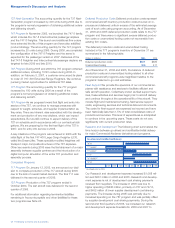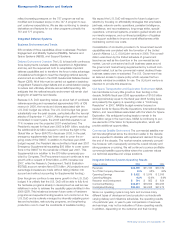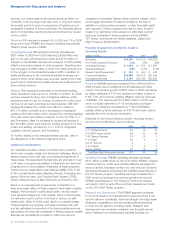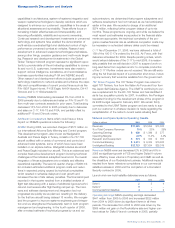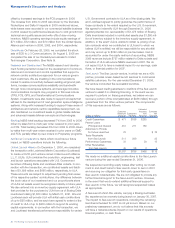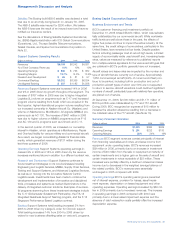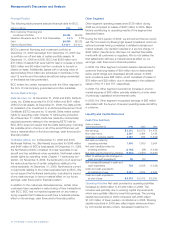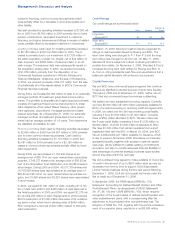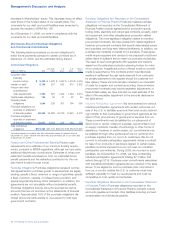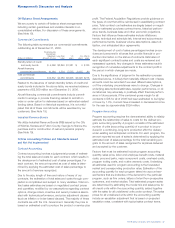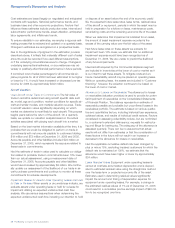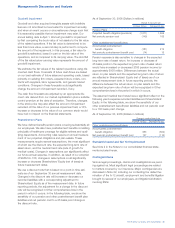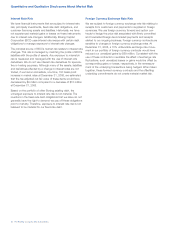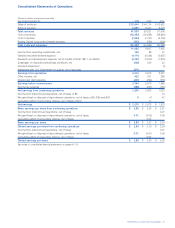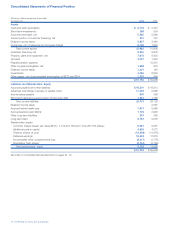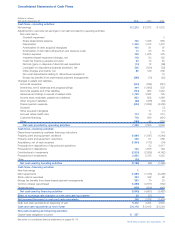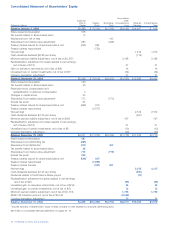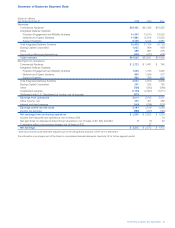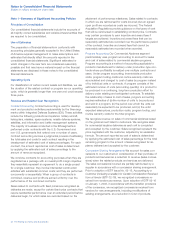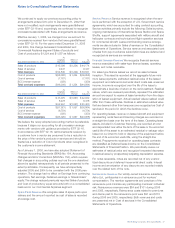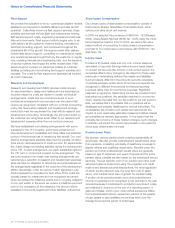Boeing 2006 Annual Report Download - page 40
Download and view the complete annual report
Please find page 40 of the 2006 Boeing annual report below. You can navigate through the pages in the report by either clicking on the pages listed below, or by using the keyword search tool below to find specific information within the annual report.Cost estimates are based largely on negotiated and anticipated
contracts with suppliers, historical performance trends, and
business base and other economic projections. Factors that
influence these estimates include production rates, internal and
subcontractor performance trends, asset utilization, anticipated
labor agreements, and inflationary trends.
To ensure reliability in our estimates, we employ a rigorous esti-
mating process that is reviewed and updated on a quarterly basis.
Changes in estimates are recognized on a prospective basis.
Due to the significance of judgment in the estimation process
described above, it is likely that materially different cost of sales
amounts could be recorded if we used different assumptions,
or if the underlying circumstances were to change. Changes in
underlying assumptions/estimates, or circumstances may ad-
versely or positively affect financial performance in future periods.
If combined cost of sales percentages for all commercial air-
plane programs for all of 2006 had been estimated to be higher
or lower by 1%, it would have increased or decreased pre-tax
income for 2006 by approximately $243 million.
Aircraft Valuation
Used Aircraft Under Trade-in Commitments The fair value of
trade-in aircraft is determined using aircraft specific data such
as, model, age and condition, market conditions for specific air-
craft and similar models, and multiple valuation sources. Trade-
in aircraft valuation varies significantly depending on which
market we determine is most likely for each aircraft. This process
begins years before the return of the aircraft. On a quarterly
basis, we update our valuation analysis based on the actual
activities associated with placing each aircraft into a market.
Based on the best market information available at the time, it is
probable that we would be obligated to perform on trade-in
commitments with net amounts payable to customers totaling
$19 million and $72 million at December 31, 2006 and 2005.
Accounts payable and other liabilities included $22 million at
December 31, 2005, which represents the exposure related to
these trade-in commitments.
Had the estimate of trade-in value used to calculate our obliga-
tion related to probable trade-in commitments been 10% lower
than our actual assessment, using a measurement date of
December 31, 2006, Accounts payable and other liabilities
would have increased by approximately $2 million. We continu-
ally update our assessment of the likelihood of our trade-in air-
craft purchase commitments and continue to monitor all these
commitments for adverse developments.
Impairment Review for Assets Under Operating Leases and Held
for Sale or Re-lease When events or circumstances indicate, we
evaluate assets under operating lease or held for re-lease for
impairment utilizing an expected undiscounted cash flow
analysis. We use various assumptions when determining the
expected undiscounted cash flow including our intention to hold
or dispose of an asset before the end of its economic useful
life, the expected future lease rates, lease terms, residual value
of the aircraft or equipment, periods in which the asset may be
held in preparation for a follow-on lease, maintenance costs,
remarketing costs and the remaining economic life of the asset.
When we determine that impairment is indicated for an asset,
the amount of asset impairment expense recorded is the
excess of the carrying value over the fair value of the asset.
Had future lease rates on these assets we evaluate for
impairment been 10% lower, we estimate that no additional
impairment expense would have been recognized as of
December 31, 2006. We are unable to predict the likelihood
of any future impairments.
Used aircraft acquired by the Commercial Airplanes segment
are included in Inventories at the lower of cost or market as it
is our intent to sell these assets. To mitigate costs and en-
hance marketability, aircraft may be placed on operating lease.
While on operating lease, the assets are included in “Customer
financing,” however, the valuation continues to be based on
the lower of cost or market.
Allowance for Losses on Receivables The allowance for losses
on receivables (valuation provision) is used to provide for poten-
tial impairment of receivables on the Consolidated Statements
of Financial Position. The balance represents an estimate of
reasonably possible and probable but unconfirmed losses in the
receivables portfolio. The estimate is based on various qualita-
tive and quantitative factors, including historical loss experience,
collateral values, and results of individual credit reviews. Factors
considered in assessing collectibility include, but are not limited
to, a customer’s extended delinquency, requests for restructur-
ing and filings for bankruptcy. The adequacy of the allowance is
assessed quarterly. There can be no assurance that actual
results will not differ from estimates or that the consideration of
these factors in the future will not result in an increase or
decrease to the allowance for losses on receivables.
Had the applicable cumulative default rate been changed by
plus or minus 15%, excluding impaired customers for which the
default rate is maintained at 100%, we estimate that the
allowance would have been higher or lower by approximately
$34 million.
Lease Residual Values Equipment under operating leases is
carried at cost less accumulated depreciation and is depreci-
ated to estimated residual value using the straight-line method
over the lease term or projected economic life of the asset.
Estimates used in determining residual values significantly
impact the amount and timing of depreciation expense for
equipment under operating leases. For example, a change in
the estimated residual values of 1% as of December 31, 2006
could result in a cumulative pre-tax earnings impact of $20 mil-
lion to be recognized over time.
38 The Boeing Company and Subsidiaries
Management’s Discussion and Analysis


